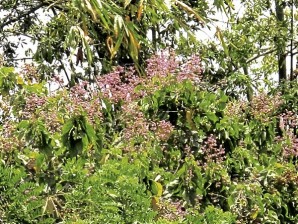Tan-ag (Bitan-ag)
 One of my fondest childhood memories is that of the Bitan-ag (Kleinhovia hospita), a huge tree with pretty pink flowers and fruit that looked like green baubles. It looked ancient with its branches hanging down over the river bank and its knobby roots twisting here and there under the water.
One of my fondest childhood memories is that of the Bitan-ag (Kleinhovia hospita), a huge tree with pretty pink flowers and fruit that looked like green baubles. It looked ancient with its branches hanging down over the river bank and its knobby roots twisting here and there under the water.
This was my favorite “snack bar.” I would wade in and grope under the Bitan-ag’s gnarled roots, and would usually be rewarded with a luscious freshwater shrimp or a tiny succulent fish.
The tree itself was host to a lot of parasitic plants and other guests, like lizards and insects. That’s why it is called the “guest tree.” It also served as the usual arena for our neighbors Teresa and Dorong, the cantankerous couple who, after chasing each other with a bolo or a broom, would invariably end up with the wife riding high on one of the branches and the husband looking up, begging her to come home. The tree must have had some calming power, as the couple often went back home together after some long-drawn, dramatic scene by the Bitan-ag.
When I last visited the river of my childhood, I pushed my way through rows of banana trees to pay homage to my Bitan-ag. But it was gone. The silt had risen and the water was dark, filled with the toxins that had poured in from plantations.
The river bank was bare, except for the banana roots that looked like ugly intruders clawing at the soil. My heart sank and I was filled with a sense of foreboding.
What has happened to my Bitan-ag is yet another portent of what is to come. The future looks bleak—for my children, for my children’s children and the generations beyond.
















